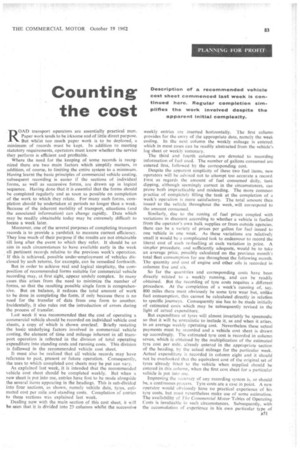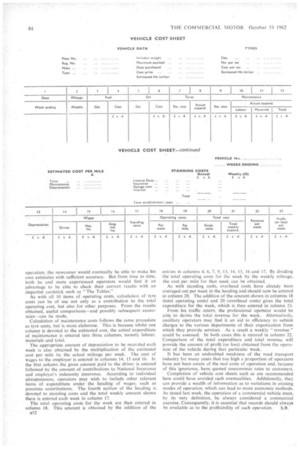Counting the cost
Page 85

Page 86

If you've noticed an error in this article please click here to report it so we can fix it.
Description of a recommended vehicle cost sheet commenced last week is continued here. Regular completion simplifies the work involved despite the apparent initial complexity.
ROAD transport operators are essentially practical men. Paper work tends to be irksome and of little direct purpose. But whilst too much paper work is to be deplored, a minimum of records must be kept. In addition to meeting statutory requirements, operators must know whether the service they perform is efficient and profitable.
Where the need for the keeping of some records is recognized there are two main factors which simplify matters, in addition, of course, to limiting the entire system to a minimum. Having learnt the basic principles of commercial vehicle costing, subsequent recording is easier if the sections of individual forms, as well as successive forms, are drawn up in logical sequence. Having done that it is essential that the forms should be completed regularly and as soon as possible on completion of the work to which they relate. For'many such forms, completion should be undertaken at periods no longer than a week. Because of the inherent mobility of transport, situations (and the associated information) can change rapidly. Data which may be readily obtainable today may be extremely difficult to locate a week later.
Moreover, one of the several Purposes of completing transport records is to provide a yardstick to measure current efficiency. They lose much of their purpose if the results are not obtainable till long after the event to which they refer. It should be an aim in such circumstances to have available early in the week all pertinent records relative to the previous week's operation. ' If this is achieved, possible under-employment of vehicles disclosed by such returns, for example, can be remedied forthwith.
But in order to achieve real and logical simplicity, the composition of recommended forms suitable for commercial vehicle recording may, at first sight, appear unduly complex. In many cases this arises from the need to minimize the number of forms, so that the resulting possible single form is comprehensive. But on balance, it reduces the total amount of work to be done in completing the form, if only because there is no need for the transfer of data from one form to another. Incidentally, it also rules out the introduction of errors during the process of transfer. .
Last week it was recommended that the cost of operating a commercial vehicle should be recorded on individual vehicle cost sheets, a copy of which is shown overleaf. Briefly restating the basic underlying factors involved in commercial vehicle costing, the element of time and mileage inherent in all transport operation is reflected in the division of total operating expenditure into standing costs and running costs. This division is followed in the recommended vehicle cost sheet.
It must also be realized that all vehicle records may have reference to past, present or future operation. Consequently, the uses to which completed cost sheets may be put can vary.
As explained last week, it is intended that the recommended N,ehicie cost sheet should be completed weekly. But when a new sheet is put into use, entries have first to be made alongside the several items appearing in the headings. This is sub-divided into four sections, as shown, namely vehicle data, tyros, estimated cost per mile and standing costs. Completion of entries to these sections was explained last week.
Dealing now with the main section of this cost sheet, it will be seen that it is divided into 23 columns whilst the successive weekly entries are inserted horizontally. The first column provides for the entry of the appropriate date, namely the week ending. In the next column the weekly mileage is entered, which in most cases can be readily abstracted from the vehicle's log sheet or weekly summary.
The third and fourth columns are devoted to recording information of fuel used. The number of gallons consumed are entered first, followed by the corresponding cost.
Despite the apparent simplicity of these two fuel items, new operators will be advised riot to attempt too accurate a record. First as regards the amount of fuel consumed daily, tank dipping, although seemingly correct in the circumstances, can prove both impracticable and misleading. The more common practice of completely filling the tank at the completion of a week's operation is more satisfactory. The total amount then issued to the vehicle throughout the week, will correspond to the amount consumed.
Similarly, due to the zoning of fuel prices coupled with variations in discount according to whether a vehicle is fuelled from the operator's own bulk supplies or from outside agencies, there can be a variety of prices per gallon for fuel issued to one vehicle in one week. As these variations are relatively small it would be a complicated task to endeavour to record the literal cost of each re-fuelling at each variation in price. A simpler procedure. and sufficiently adequate, would be to take an average price, possibly calculated on the previous month's total fleet consumption for use throughout the following month. The quantity and cost of engine and other oils is recorded in columns five and six.
So far the quantities and corresponding costs have been directly related to a weekly running, and can be readily obtained. But the recording of tyre costs requires a different procedure. At the completion of a week's running of, say, 800 miles there must obviously be some tyre wear but, unlike fuel consumption, this cannot be calculated directly in relation to specific journeys. Consequently uie has to be made initially of estimated costs which may be subsequently revised in the light of actual expenditure.
But expenditure ot tyres will almost invariably be spasmodic so that it will be unrealistic to include it, as and when it arises, in an average weekly operating cost. Nevertheless these actual payments must be recorded and a vehicle cost sheet is drawn up accordingly. The estimated tyre cost is recorded in column seven, which is obtained by the multiplication of the estimated tyre cost per mile, already entered in the appropriate section of the heading, by the actual mileage for the particular week. Actual expenditure is recorded in column eight and it should not be overlooked that the equivalent cost of the original set of tyres already fitted to the vehicle when supplied should be entered in this column, when the first cost sheet for a particular vehicle is put into use.
Improving the accuracy of any recording system is, or should he, a continuous process. Tyre costs are a case in point. A new operator would obviously have no practical experience of his tyre costs, but must nevertheless make use of some estimation. The availability of The Commercial Motor Tables of Operating Costs is invaluable in such circumstances. Subsequently, with the accumulation of experience in his own particular type of
operation, the newcomer would eventually be able to make his own estimates with sufficient accuracy. But from time to time, both he and more experienced operators would find it an advantage to be able to check their current results with an impartial yardstick such as "The Tables.". As with all 10 items of operating costs, calculation of tyre costs can be of use not only as a contribution to the total operating cost, but also for other purposes. From the results obtained, useful comparisons—and possibly subsequent economies—can be made.
Calculation of maintenance costs follows the same procedure as tyre costs, but is more elaborate. This is because whilst one column is devoted to the estimated cost, the actual expenditure of maintenance is entered into three columns, namely labour, materials and total.
The appropriate amount of depreciation to be recorded each week is also obtained by the multiplication of the estimated cost per mile by the actual mileage per week. The cost of wages to the employer is entered in columns 14. 15 and 16. In the first column the gross amount paid to the driver is entered followed by the amount of contributions to National Insurance and employer's indemnity insurance. According to individual circumstances, operators may wish to include other relevant items of expenditure under the beading of wages, such as pensions contributions. The fourth section of the heading is devoted to standing costs and the total weekly amount shown there is entered each week in column 17.
The total operating costs for the week are then entered in column 18. This amount is obtained by the addition of the entries in columns 4, 6, 7, 9, 13, 14, 15, 16 and 17. By dividing the total operating costs for the week by the weekly mileage, the cost per mile for that week can be obtained.
As with standing cosis, overhead costs have already been averaged out per week in the heading and should now be entered in column 20. The addition of the. amount-shown in columns 18 (total operating costs) and 20 (overhead costs) gives the total expenditure for the week, which is then entered in column 21.
From his traffic return, the professional operator would be able to derive the total revenue for the week. Alternatively, ancillary operators may find it an aid to efficiency to submit charges to the various departments of their organization from which they. provide services. As a result a weekly " revenue " could be assessed. In both casesthis is entered in column 22. Comparison of the total . expenditure and total revenue will provide the amount of profit (or loss) obtained from the operation of the vehicle during that particular week.
It has been an undoubted weakness of the road transport industry for many years that too high a proportion of operators have not been aware of the real costs of operation and, because of this ignorance, have quoted uneconomic rates to customers.
Completion of vehicle cost sheets such as are recommended here could have avoided such eventualities. Additionally, they can provide a wealth of information as to variations in existing modes of operation, which can lead to more economic methods. As stated last week, the operation of a commercial vehicle must, by its very definition, be always considered a commercial exercise. Consequently, it is essential that records should always be available as to the profitability of such operation. S.B.




































































































































